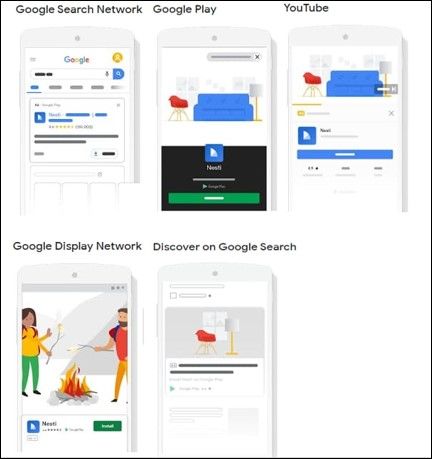Google AdWords
Millions of people use Google every second, and the majority of SERPs have Google advertising at the top and bottom of the organic results. Because Google controls approximately 80% of the search engine market, there are several options to make the business or brand known. As a result, when people search for the services or products supplied, Google AdWords could be a beneficial decision to promote a business in front of people and obtain relevant and quality traffic to the website.
Let’s take a look at what Google advertisements are, the different types of ads, and how they function.
What is Google Ads (Earlier known as Google AdWords)?

Google Adwords is a Google online advertising platform that allows you to build ads and show them to people who are interested in your services or products and are looking for the keywords you’ve chosen.
The Google Ads platform is based on pay-per-click (PPC) advertising. The second question is, what exactly is PPC?
Pay Per Click (PPC) is an internet marketing approach in which advertisers are charged each time their ad is clicked.
Google Ads allows you to
- Create a large audience for your company or brand.
- Advertise to both local and international audiences.
- Reach out to the appropriate people at the right time.
- Keep an eye on your spending.
Types of ads in Google Ads (AdWords)

Let’s have a look at each ad type in detail
Search Ads

When a user conducts a Google search, a list of results is displayed on the search engine result page (SERP), with search advertising appearing above organic results.
When a user searches for “Digital marketing services in Mumbai,” for example, the search r
The ones designated as “Ad” in the preceding image are adverts, and the result page will look like this.
Main factors in search ads are
Targeting:
You can, for example, select a single or many geographies in which the ad will appear.
Search query and keyword:
What the user is looking for, as well as the keyword that the ad is optimized for.
The relevance of ad copy:
Advertisements that display in the SERP should be related to the search phrase. As a result, a search for cellphones should not return results for automobiles.
Landing Page experience:
The relevance of the landing page to the search query and the expectations of the searcher.
Bid:
The amount of money an advertiser is willing to spend for each click on an advertising. If two advertisers have perfect advertising and landing sites, for example, the ad with the greater bid will be prioritized.
Conversion Rate:
The percentage of visitors to your ad who complete the targeted action, which is influenced by relevance, landing page quality, and experience.
Quality score:
It’s a metric for determining the effectiveness of your adverts, landing pages, and keywords.
Display Ads

A display ad is a type of advertising in which a product or service is advertised using visuals such as photos, banners, or videos on third-party websites. Only ad-supported websites have display advertising.
ALSO READ: 13 Best Local SEO Tools to Ace Your Local Search
The user is not looking for what the ad provides, yet Google decides to display you these advertisements based on factors such as keywords, audience interest, controlled placements, and so on.
Google selects the websites to place the display ads based on the following targeting criteria.
Keywords:
The adverts are shown based on the keywords for which they have been optimised. If the ad term is “Digital Marketing Agency,” Google will choose websites with content related to this issue.
Placements:
It refers to the location where the advertisement will be shown. Add the URLs of the websites where the ad will appear. If you want your ad to appear on educational websites, for example, include advertising-supported educational websites in your targeting.
Topic:
Websites are classified under distinct subjects in Google ads. As a result, advertising may quickly choose themes that are relevant to their business. Websites about education, for example, will be featured under the category “education.”
Shopping Ads

Shopping ads provide extensive product information such as the image of the goods, its price, the merchant’s name, and so on. This ad type increases website traffic while also assisting in the generation of quality leads and conversions.
Shopping advertising would appear in the format shown below on SERPs.
ALSO READ: How to do SEO Competitor Analysis?
Actions required for running shopping ads
- You must create a Google Merchant Center and Google Ads account and link them together.
- Every 30 days, you must send product data to Google Merchant Center.
Video Ads

Advertisers can run video ads before, during, or after streaming content. Advertisements for video can be seen on YouTube and other Google Display Networks.
ALSO READ: Optimizing Your Webpage with Lazy Loading
Universal app campaign

In Google Ads, a universal app campaign (UAC) is an automated ad kind. This ad kind is beneficial to a company that has a mobile app. Advertisers can use UAC to promote their mobile app on PlayStore, Search, Display, YouTube, and other platforms. Text advertising from the app store listing are used by Google Ads. To create the ad, you’ll need a budget, some text, a starting bid, as well as languages and locations.
All of this data is used by Google Adverts to create a variety of ads in various forms. By automatically evaluating different combinations, Google displays the best-performing ad.
This is how app advertisements may appear.
How Does Google Ads (AdWords) Work?
Google Ads is based on a bidding structure. Google detects all the adverts that match the search query when consumers type a search query into a search engine. An auction is automatically generated when more than one advertiser bids on a keyword that is relevant to the user’s search query.
Ad rank determines where your ad appears in the SERPs. Let’s look at the things that influence ad rank:
Bid amount
When you set an ad’s bid, you’re telling Google that this is the most you’re ready to pay for a click on your ad. Bidding wars result in better ranks. However, placing a big bid does not guarantee a high rating.
Quality score
It shows how relevant an ad group, an ad, and the landing page are to the user’s search. A higher quality score improves ad position, raises CTR, and lowers campaign costs, resulting in better campaign results.
Following three factors controls the quality score
Expected clickthrough rate (CTR) – I
It calculates the likelihood of users clicking on your ad when it appears in the SERP for a specific keyword. Based on the position of your ad, Google Ads considers the prior performance of the keywords. Average, Above Average, and Below Average are the three possible statuses for your predicted CTR. You can expect a higher quality score if your CTR is greater than average.
Ad relevance:
It’s a matrix that determines how closely your keywords and ad copy are related. Again, there are three ad relevant regulations, such as predicted CTR, and using these statuses, you can determine which keywords are not relevant to your ad and make appropriate changes.
Landing page experience:
The relevance of your landing page to the ad and how much it is relevant to the user’s search query are factors that Google considers when determining landing page experience. The landing page experience status indicates whether or not the users who landed on the page after clicking the ad had a positive experience.
Ad Extension
Ad extension is extra information that extends the reach of your advertisement and makes it more useful to users. A phone number, supplementary links, location information, and other ad extensions are common. By increasing the value of your ad, you can improve your chances of winning the ad auction.
Using the above three factors, Google forms the basis for your Ad Rank.
Let’s take an example to understand how the auction works.
If a user searches for digital marketing services, Google will look through the AdWords advertisers pool to see if an auction will be held.
An auction begins when four advertisers bid on a keyword that Google thinks relevant to digital marketing services.
Google will now look at each ad’s quality score and bid amount using the following formula:
Ad rank = CPC (Cost-Per-Click) Bid × Quality Score
Because advertisement ‘A’ has taken first place, he will pay a lower cost per click (real CPC) than advertiser ‘B.’ Because advertiser ‘B’ has secured the second spot, he will pay a lower rate than advertiser ‘c,’ and so on. Because he lost the auction, advertiser ‘D’ will pay the maximum CPC.
As you can see, Google Ads (AdWords) can help you improve clicks, conversions, and it can also help you build user-relevant ads that deliver the results you want.
So, what is your current return on investment? Are your ads relevant to your target audience? We ensure that our best PPC services will enhance your sales, leads, and ROI.